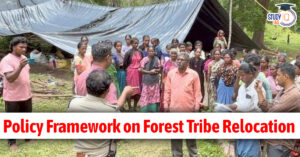Table of Contents
The Food and Agriculture Organization (FAO) of the United Nations has released the State of Food and Agriculture (SOFA) Report 2025, focusing on human-induced land degradation and its severe impact on global food security, ecosystems, and rural livelihoods.
According to the SOFA 2025 Report, land degradation affects around 1.7 billion people globally, disrupting food systems, reducing agricultural productivity, and intensifying climate risks. The report warns that agricultural expansion continues to drive nearly 90% of global deforestation, severely altering land-use patterns across the planet.
About the State of Food and Agriculture (SOFA) Report
The State of Food and Agriculture (SOFA) is one of FAO’s flagship annual reports that provides a comprehensive analysis of agricultural, economic, and environmental trends.
It serves as a global evidence base for policymakers, researchers, and international organizations to design effective agricultural and environmental policies.
Objectives of the SOFA 2025 Report
-
To examine the impact of land degradation on global food security and rural livelihoods.
-
To identify global vulnerability hotspots where degradation overlaps with poverty and hunger.
-
To provide policy recommendations for sustainable land management and restoration.
Key Highlights of the State of Food and Agriculture (SOFA) Report 2025
1. Land Degradation Threatens 1.7 Billion People
The report highlights that 1.7 billion people worldwide are directly affected by land degradation, which weakens soil fertility, reduces crop yields, and threatens long-term food security.
Land degradation also intensifies climate change by releasing stored carbon and reducing the land’s ability to absorb greenhouse gases.
2. Agricultural Expansion Drives 90% of Global Deforestation
The SOFA 2025 report identifies agricultural expansion as the primary cause of deforestation, responsible for nearly nine out of ten cases of forest loss globally.
Deforestation for crop cultivation and livestock grazing continues to reshape global land-use patterns, particularly in Latin America, Sub-Saharan Africa, and Southeast Asia.
3. India Among the Most Affected Countries
India has been identified as one of the countries most affected by human-induced land degradation.
The report finds that India has significant yield gaps caused by declining soil health, water scarcity, and deforestation. Rapid urbanization, unsustainable agricultural practices, and groundwater depletion are major contributing factors.
Regions like Rajasthan, Madhya Pradesh, Maharashtra, Karnataka, and Gujarat face severe degradation due to desertification and over-exploitation of natural resources.
4. Cropland Abandonment Increasing Globally
The SOFA 2025 report warns that around 3.6 million hectares (mha) of cropland are abandoned annually due to land degradation, soil erosion, and declining fertility.
This trend poses a direct threat to global food production and the 2030 Sustainable Development Goals (SDGs) related to Zero Hunger (SDG 2) and Life on Land (SDG 15).
5. Global Hotspots of Vulnerability
The report identifies several vulnerability hotspots where land degradation, hunger, and poverty overlap:
-
Eastern and Southern Asia – high population density and extensive land degradation.
-
Sub-Saharan Africa – widespread deforestation and poverty.
-
Latin America – agricultural expansion for cattle ranching and soybean cultivation.
These regions collectively represent the epicenters of global food insecurity, where degradation and poverty reinforce each other.
6. Economic and Environmental Consequences
Land degradation costs the global economy hundreds of billions of dollars annually through lost productivity, ecosystem damage, and food insecurity.
The FAO warns that global food production could decline by up to 12% by 2050 if current land degradation trends continue.
Environmental effects include:
-
Increased soil erosion and sedimentation
-
Reduced biodiversity
-
Disrupted water cycles
-
Higher greenhouse gas emissions
Understanding Land Degradation
Definition
Land degradation refers to the loss of the land’s biological or economic productivity due to human activities, such as deforestation, overgrazing, unsustainable agriculture, and industrial pollution.
Major Causes
-
Deforestation for agriculture and infrastructure
-
Unsustainable farming practices and overuse of fertilizers
-
Overgrazing and loss of vegetation cover
-
Mining and industrial pollution
-
Urban sprawl and land misuse
Types of Land Degradation
-
Soil erosion (by wind and water)
-
Desertification
-
Salinization and waterlogging
-
Nutrient depletion
-
Loss of soil organic matter
Impact of Land Degradation on Food Security
| Aspect | Impact |
|---|---|
| Crop Yields | Reduced productivity and declining food supply |
| Soil Fertility | Loss of essential nutrients and organic matter |
| Livelihoods | Rising poverty and rural migration |
| Biodiversity | Disruption of natural habitats and pollinator decline |
| Climate Change | Reduced carbon sequestration and higher emissions |
India’s Response to Land Degradation
India has launched several initiatives and missions to tackle land degradation and desertification.
Key Government Initiatives
-
National Action Plan for Combating Desertification (NAPCD):
Promotes afforestation, watershed development, and soil conservation. -
National Mission for Sustainable Agriculture (NMSA):
Focuses on improving soil health, rainwater management, and crop diversification. -
Pradhan Mantri Krishi Sinchayee Yojana (PMKSY):
Aims to achieve “per drop more crop” by improving irrigation efficiency. -
Soil Health Card Scheme:
Provides farmers with detailed soil health reports to optimize fertilizer usage. -
National Afforestation Programme (NAP):
Encourages community-based forest management and plantation drives.
International Commitments
-
India is a signatory to the United Nations Convention to Combat Desertification (UNCCD).
-
India has pledged to restore 26 million hectares of degraded land by 2030 under the Bonn Challenge.
FAO’s Recommendations in the SOFA 2025 Report
-
Promote Sustainable Land Management (SLM):
Adopt eco-friendly farming methods like crop rotation, zero tillage, and agroforestry. -
Restore Degraded Lands:
Encourage reforestation, soil restoration, and watershed projects. -
Invest in Soil Health:
Strengthen monitoring and testing systems to track soil fertility. -
Empower Local Communities:
Support indigenous practices and empower farmers through financial and technical assistance. -
Use Technology and Data:
Employ AI, satellite imagery, and GIS to track land degradation and plan interventions. -
Enhance Global Cooperation:
Strengthen partnerships under FAO, UNCCD, and COP 16 Desertification Framework.
Significance of the SOFA 2025 Report
The SOFA 2025 Report is critical for understanding how human actions are reshaping the planet’s ecosystems. It provides policymakers with vital insights to achieve:
-
Sustainable food systems
-
Land restoration and reforestation
-
Climate resilience
-
Biodiversity conservation
The report also supports global goals like:
-
SDG 2: Zero Hunger
-
SDG 13: Climate Action
-
SDG 15: Life on Land
Conclusion
The State of Food and Agriculture (SOFA) Report 2025 serves as a wake-up call for nations worldwide. With 1.7 billion people directly affected by land degradation, urgent global action is needed to restore land health, improve food security, and build climate-resilient economies.
For India, where agriculture remains the backbone of livelihoods, sustainable land management, soil conservation, and reforestation must be prioritized to ensure food security for future generations.


 India Needs Nutritional Transformation: ...
India Needs Nutritional Transformation: ...
 Policy Framework on Forest Tribe Relocat...
Policy Framework on Forest Tribe Relocat...
 Tropical Forests Forever Facility (TFFF)...
Tropical Forests Forever Facility (TFFF)...

























